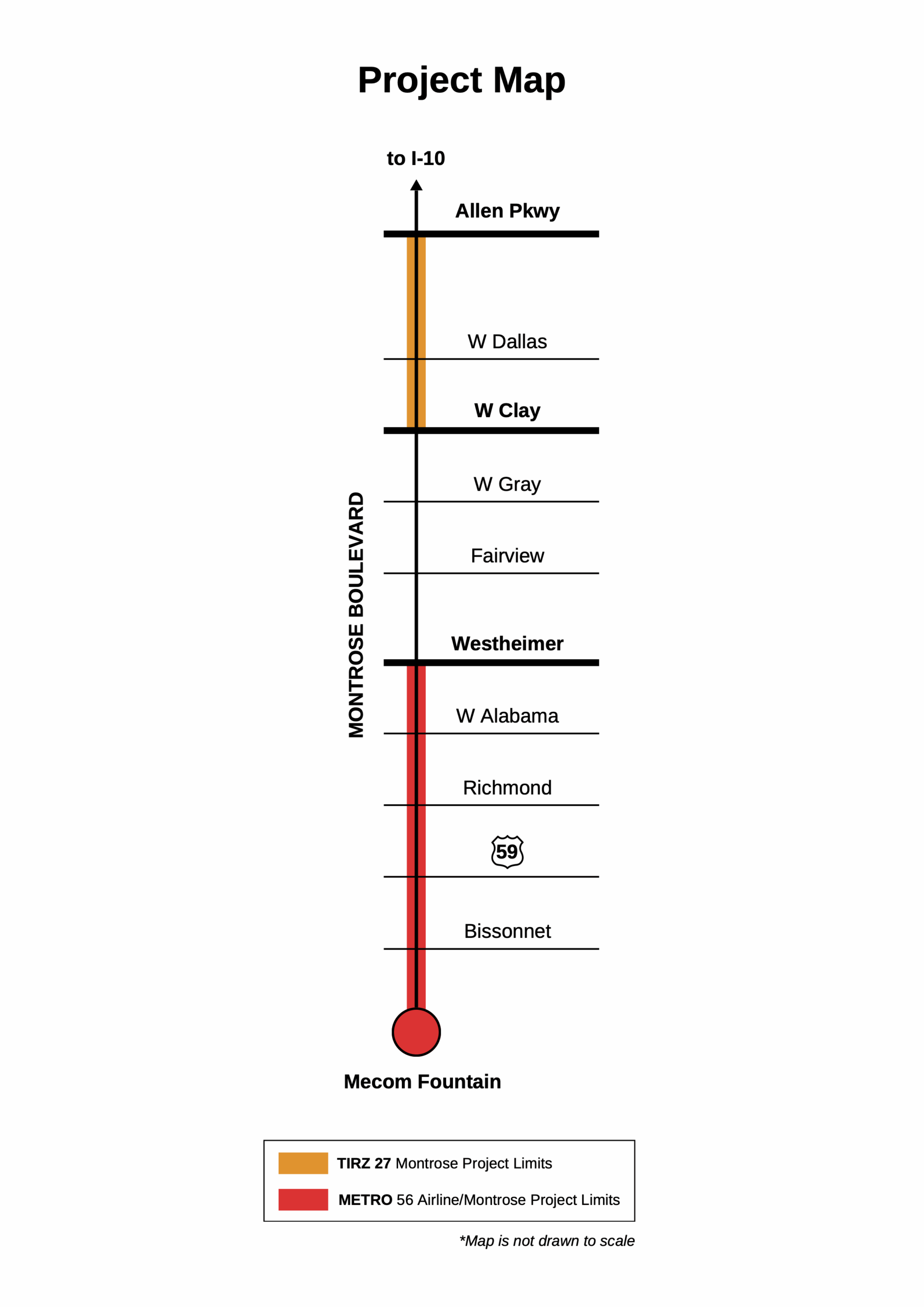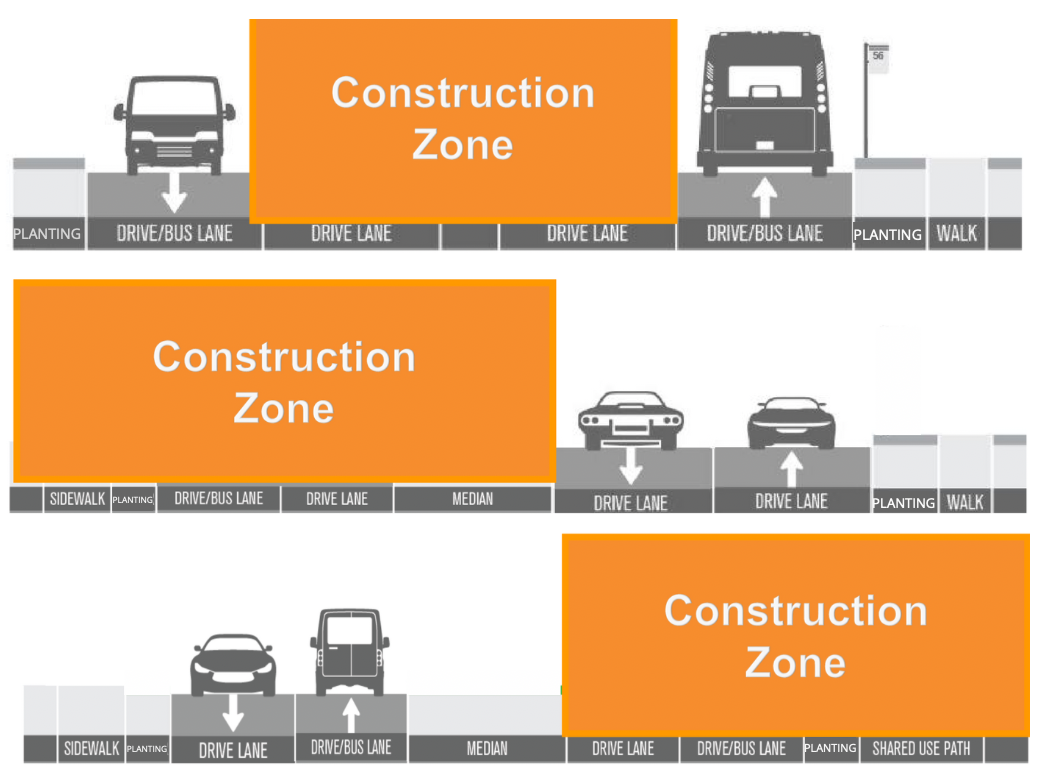URGENT – NOTICE Of WATER SHUTOFF
The water will be shut off Thursday, August 7, from 10pm – 6am at Montrose and West Clay. This may or may not affect your property. Written notices have been distributed to the affected properties.
If your water is off past this time, please call the City’s non-emergency hotline 3-1-1. For other inquiries please email info@montrosehtx.org.
Montrose Blvd Construction Begins March/April 2025
Montrose Boulevard is being fully reconstructed from Allen Parkway to W Clay Street as a 4-lane concreate roadway with a median, sidewalks, trees, signals, and a pedestrian bridge. Updates on this website will be given weekly and kept up to date. The graphic below illustrates the boundaries of TIRZ 27’s improvement project and METRO’s 56 Airline/Montrose Project limits. If you’d like to learn more about METRO’s project click the link here.
What to expect during construction
- Minimum one lane of traffic in each direction
- Driveway access will be maintained at all times
- Expect delays, please plan accordingly
- Construction will take approx. one year
- Uniformed police officers will be present as needed
Construction Phasing
Phase I
Allen Parkway to
W Dallas Street
Phase II
W Dallas Street to
W Clay Street
Construction Phasing Example
Project Limits
Allen Parkway to
W Clay Street
Construction Cost
$17.9M
Contractor
MC2 Civil, LLC
Timeline
Begin March/April 2025
End 2nd Quarter of 2026
About The Improvement Project
Project Goals
- Adhere to the City’s guiding mobility and safety principles: Enhancing pedestrian safety with new sidewalks, crosswalks, and better lighting to ensure Montrose Boulevard is a welcoming corridor for all.
- Improve drainage infrastructure: Upgrading stormwater infrastructure to reduce flooding, protect properties, and keep our streets accessible during heavy rain.
- Improve roadway surfaces: Resurfacing and repairing the roadway for smoother travel, better accessibility, and a more durable surface to serve the community for years to come.
- Preserve as many trees as possible and add new ones:Preserving the mature trees that define Montrose Boulevard’s charm by incorporating thoughtful design and construction practices that protect their roots and health. In addition, new trees will also be added along Montrose Blvd between Allen Parkway to West Clay Street.
Proposed Project Improvements
Proposed Typical Roadway Sections
Allen Parkway to W Dallas Street
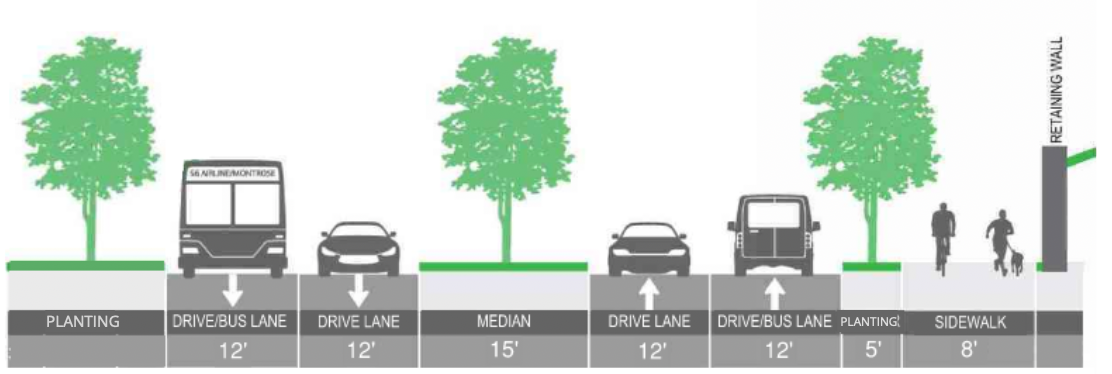
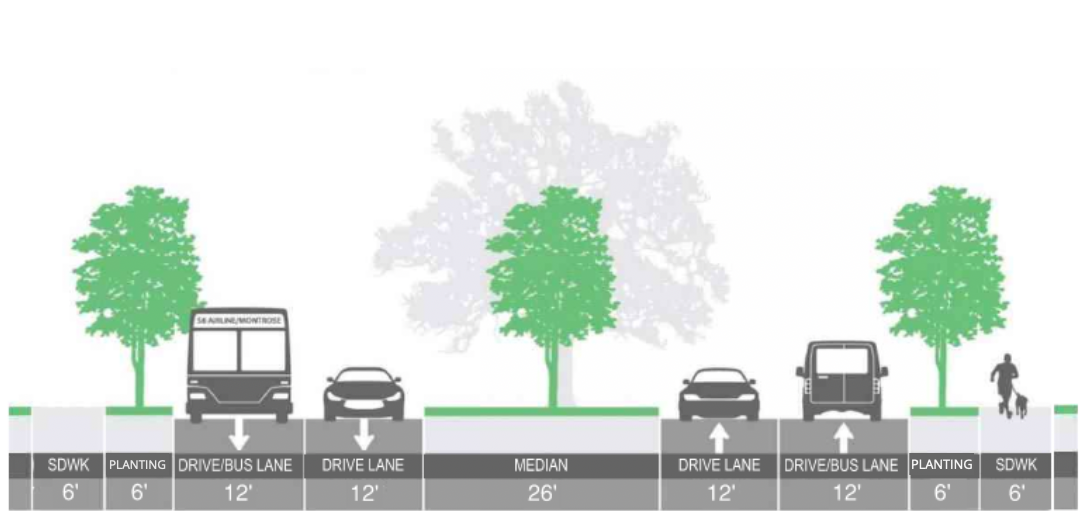
Pedestrian Safety
The Montrose Project prioritizes pedestrian safety as a key component of its design, spanning from Allen Parkway to West Clay Street. Sidewalk pedestrian safety measures include an enlarged safety buffer to City of Houston standards to bring the sidewalk further away from the street; the safety buffer will include existing and proposed trees to enhance safety and shade for pedestrians. Intersection pedestrian safety measures include upgraded pedestrian crossings and ramps with signals, no right-turn on red signs, high-visibility crosswalks, and improved intersection accessibility to meet ADA and City of Houston standards. Installation of a HAWK (High-Intensity Activated Crosswalk) signal at the W Clay Street intersection near Wharton Elementary provides a safer pedestrian crossing. The project introduces City-owned Davit double luminaire streetlights along the corridor, enhancing lighting for the sidewalk, improving safety and security. Also, a significant number of trees are being added to provide more shade for pedestrians traversing the corridor. The MBIP seeks to transform Montrose Boulevard into a safer, more walkable corridor for all users.
The sidewalk enhancements in the Montrose Project aim to improve pedestrian accessibility and safety while maintaining tree preservation goals. From Allen Parkway to W Dallas Street, the east side of Montrose Blvd will feature an 8-foot-wide sidewalk, providing ample space for pedestrians including those with mobility challenges; the west side will maintain its existing landscape buffer and preserve mature trees. Between W Dallas Street to W Clay Street, the esat side will have 6-foot-wide sidewalks. Similarly, the west side will also feature 6-foot-wide sidewalks. The sidewalks will be narrowed down to either 4- or 5-ft around the existing trees to avoid impacting them.
In collaboration with Downtown TIRZ 3, a pedestrian bridge is being installed over Allen Parkway to safely connect pedestrians from Montrose to Buffalo Bayou Park.
Drainage Infrastructure
The inline detention system proposed for the Montrose Boulevard Improvement Project (MBIP) Segment 1 is a critical component of the project’s drainage enhancement strategy, designed to mitigate flooding along the corridor from Allen Parkway to West Clay Street. This system replaces the outdated and undersized stormwater infrastructure—currently consisting of 48-inch and 54-inch pipes—with a modern, high-capacity solution to better manage stormwater runoff in this flood-prone area of Houston.
The core of the inline detention system features a network of large, 10-foot by 10-foot reinforced concrete box culverts integrated directly into the stormwater conveyance path beneath Montrose Boulevard. The system is engineered to accommodate a two-year rainfall event and providing a detention capacity of roughly five acre-feet (approximately 1.6 million gallons). This capacity helps slow the flow of stormwater, reducing peak runoff rates and alleviating pressure on downstream infrastructure, including the Buffalo Bayou watershed, where Montrose Boulevard serves as a primary drainage spine.
Key elements of the inline detention system include:
- Upgraded Conveyance: The 10×10-foot box culverts significantly increase the hydraulic capacity compared to the existing pipes, allowing for faster and more efficient movement of stormwater during heavy rain events.
- Detention Functionality: The storm sewers will temporarily detain water, releasing it at a controlled rate to prevent overwhelming downstream systems. This detention reduces flash flooding risks in the surrounding area.
- Integration with Roadway Improvements: The system is installed beneath the reconstructed roadway, aligning with the project’s goals of resurfacing and enhancing Montrose Boulevard. This integration minimizes surface disruption while addressing drainage needs.
- Compliance with Standards: The design adheres to City of Houston requirements, ensuring compatibility with local stormwater management regulations and resilience against updated rainfall data.
The inline detention system supports the broader MBIP Segment 1 objectives by enhancing drainage performance without sacrificing the corridor’s aesthetic or functional character. By situating storage underground, it preserves surface space for the project’s safety enhancements—like improved sidewalks and protects existing trees where possible, addressing community concerns about tree preservation. This approach reflects a balance between infrastructure necessity and Montrose’s urban landscape, ensuring the boulevard remains a vibrant, safe, and flood-resilient artery for the community.
For detailed schematics or further technical specifics, residents are encouraged to refer to the final design plans submitted by Montrose TIRZ 27 to the City of Houston, available at this link: https://montrosehtx.org/wp-content/uploads/2025/01/Montrose-BLVD-2025-01-09-Roadway-Schematic.pdf
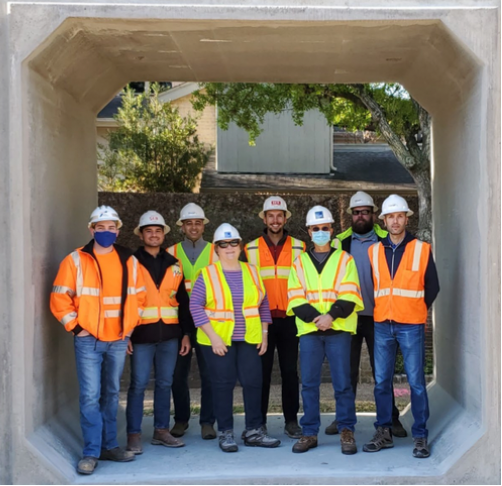
*Example of 10-ft x 10-ft storm sewer.
- 10-ft x 10-ft storm sewers
- 5 ac-ft of detention
- Consistent with regional solution
Roadway Improvements
The roadway portion of the Montrose Project ensures that Montrose Boulevard maintains its existing general-purpose lane width and number, featuring four 12-foot lanes – two in each direction – to preserve reliable service for emergency responders and accommodate current and projected 2040 traffic demands. The existing asphalt and concrete pavement is being upgraded to an 11-inch concrete pavement, designed to last at least 50 years. The corridor will also be upgraded to support METRO BOOST 56, a high-frequency bus service, enhancing public transit options and connectivity within the neighborhood. Key roadway enhancements include an upgraded traffic signal at W Dallas Street to improve traffic flow and safety and the HAWK signal at W Clay Street. The project introduces City-owned Davit double luminaire streetlights along the corridor, enhancing lighting for the BOOST corridor and sidewalks, improving safety and security, and increasing visibility and road safety for all users, particularly in an area identified as part of Houston’s High Injury Network.
Tree Conservation and Improvements
The tree planting will include Live Oaks to complement the existing live oaks that are being preserved along the roadway and adding Lanana Cypress trees north of W Dallas Street, which arose out of community engagement and serves as an aesthetic transition to Buffalo Bayou Park.
The tree maintenance will include regular watering and tree replacements for 4 years after the trees have initially been planted. Trees can play a crucial role in mitigating urban heat island effects. By providing shade and reducing surface temperatures, trees help counteract the heat trapped by concrete and asphalt in this densely built area. Through evapotranspiration, they release water vapor, cooling the surrounding air naturally. Planting native species like live oaks along Montrose Boulevard could lower ambient temperatures, improve air quality, and enhance the neighborhood’s charm, making it more comfortable for residents during Houston’s sweltering summers.
Latest Construction Info
Updated Weekly
Highlighted Text Indicates Closures
Montrose Boulevard Construction activities planned for December 14 – December 20, 2025:
- Montrose Blvd from W Clay St to Allen Parkway is at one lane in each direction.
- Driveway access will be maintained.
- The intersection work will continue at Allen Parkway. Expect delays.
- Anticipated duration: one week
- East sidewalk will be open along Montrose Blvd.
- The sidewalk at the four corners of Allen Parkway will be closed for safety.
- Anticipated duration: two weeks
- Pedestrian detours to safely cross Allen Parkway are in-place via Stanford Street and Waugh Drive.
- Allen Parkway closures
- The frontage roads will have a single lane closure in each directoin..
- The U-turn lane will be closed.
- The underpass will have a single lane closure in each direction.
- W Clay Street intersection is closed.
- A flagger is present to help people safely cross the road.
- Anticipated duration: three weeks
As part of the Montrose Blvd project goal to preserve as many trees as possible, the approved tree protection measures will be in place by June 25 for the trees south of W Dallas Street on the west side. This includes tree protection fencing to protect the tree trunks and a tree health focused approach to pruning that allows equipment enough room for storm sewer installation. All tree protection measures will be per the City of Houston approved tree protection plan.
The Montrose Blvd sidewalk from W Dallas St to Allen Parkway will be closed from Monday, July 21 to Friday, July 25 for removal and replacement. The temporary asphalt sidewalk will be shifted further from the roadway to ensure walkability and safety during upcoming phases construction.
Beginning July 10th, the Montrose at Dallas intersection will be closed to east-west traffic for storm sewer installation, which will last up to five days. Westbound drivers must turn onto Montrose. Eastbound drivers must utilize Waugh Drive. Follow detour signs. Expect delays.
The northwest quadrant of the Montrose and Dallas intersection is closed. Westbound through-traffic on Dallas must turn left or right onto Montrose. Detours direct drivers back to Dallas via Waugh. Eastbound traffic on Dallas is down to one lane.
From 9am to 3pm on June 25 the east side crosswalk at Montrose and Dallas will be closed for utility installation. We are prioritizing your safety and apologize for any inconvenience this may cause.
- Thursday night all southbound lanes will be closed from 9pm to 4am.
- Friday night all northbound lanes will be closed from 9pm to 4am
- One northbound and one southbound lane on Montrose Blvd between Allen Pkwy and W Dallas will be closed until early Fall 2025.
- One westbound lane is closed at the W Dallas Street intersection. A detour is in place to direct traffic to W Dallas Street via Waugh Drive. Expect delays.
- Construction begins 4/3. One Northbound lane will be closed between W Dallas and Allen Parkway. Expect Delays.
- 4/7-8: One northbound lane will be closed
- 4/9: one northbound and one southbound lane will be closed at Allen Pkwy
